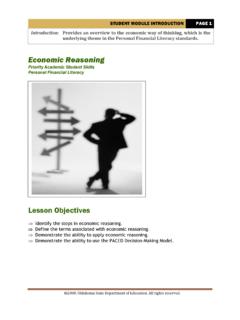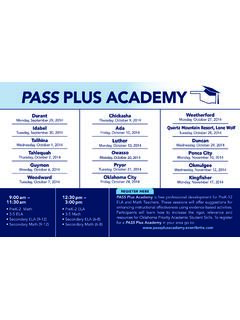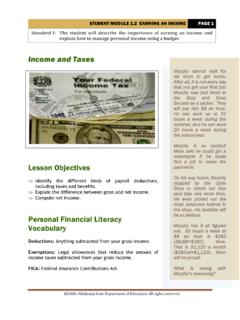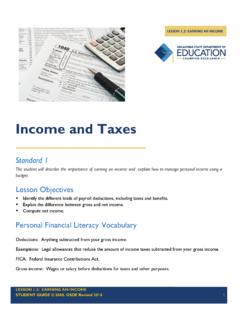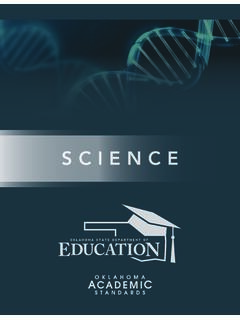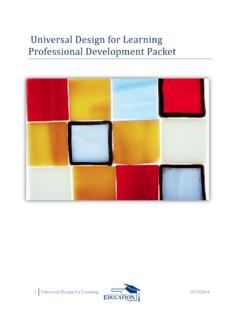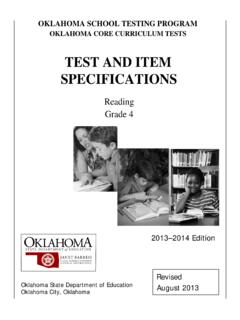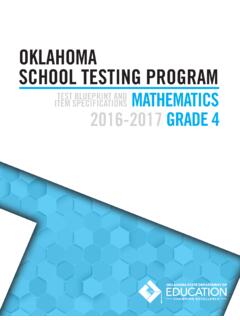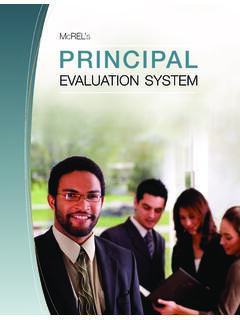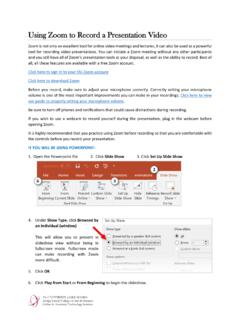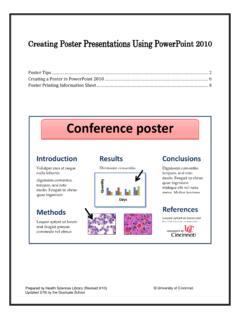Transcription of Academic Interventions: Improving Outcomes for ALL Students
1 Academic Interventions: Improving Outcomes for ALL Students 1. Contents Overview .. 3. Background .. 3. Materials/Resources .. 3. powerpoint presentation .. 3. presentation Length .. 4. Activity .. 4. Additional Resources .. 4. powerpoint .. 5. Priming Questions Worksheet .. 34. 2. Overview Professional development modules developed by the OSDE-SES are intended to assist local educational agencies (LEAs) in providing professional development for educators. Each module includes relevant background information, activities/materials, and a scripted powerpoint presentation for a particular topic area. These modules are intended for use in a workshop or other professional development setting ( faculty meeting, PLC meeting).
2 Presenters are free to use the modules in whichever way they choose. This module will assist educators in the knowledge and application of high quality classroom instruction for all Students , including Students with disabilities. It addresses the implementation of Academic interventions necessary for schools to meet the diverse needs of Students . Background Academic interventions are additional instruction and supports that supplements the general curriculum (regular classroom instruction) and are necessary to improve Academic performance for some Students . A successful Academic intervention process includes providing quality instruction with interventions matched to student need, and monitoring progress frequently to make decisions about changes in instruction, interventions and/or student goals.
3 Academic interventions are critical in ensuring a student's educational performance is not based primarily on a lack of appropriate instruction in reading (including the essential components: phonemic awareness; phonics; vocabulary development; reading fluency, including oral reading skills; and reading comprehension strategies), math, or limited English proficiency. It is very important to note that Academic interventions should be provided to ALL Students [regular education, special education, English Language Learners (ELL)] in need of intervention. Materials/Resources powerpoint presentation This presentation is intended to engage staff in meaningful professional development.
4 Presenters should become familiar with the powerpoint notes and other materials/resources included in this module, as well as additional resources related to the topic. There is space after each slide's presentation where the presenter may note any additional information related to LEA/school expectations or procedures. Slide operation: Slides load completely. No clicks are necessary (except to advance to the next slide). Under each slide are presenter discussions and/or questions to draw in the audience and activity opportunities. 3. presentation Length This powerpoint presentation was developed as a tool to assist sites in Improving their Academic intervention process.
5 The presentation will take approximately two hours. However, it can be shortened to about one hour by presenting the information only and not including the activities intended to examine the intervention process in place at the site. If the shorter version is utilized, slides 9-14, 32-36, the Priming Questions Sheet and the closing activity discussed on page 24. will need removed from the module. Activity The activity for this module is embedded into the powerpoint presentation . The worksheet for the activity can be located on page 34 (Appendix A) and needs to be provided to each participant prior to beginning the presentation .
6 Additional Resources These are additional resources for educators to share with Students and parents. A description for each will provide educators with a better understanding of the documents and how they may be utilized. OSDE-SES Academic Interventions Self-Assessment- Resource for administrators and staff to evaluate the Academic intervention process at their school. OSDE-SES Academic Interventions Self-Assessment Instructions- Resource for administrators and staff to aid in the process of completing the Academic Interventions Self-Assessment sheet. OSDE-SES Academic Interventions Self-Assessment Professional Development Resource Sheet- Reference for specific tools and resources helpful in the implementation of Academic interventions.
7 Title of resource, brief description, and link to URL provided. 4. powerpoint Slide 1: Presenter: Welcome, today we will be discussing Academic interventions. Academic interventions are additional instruction that supplements the general curriculum (regular classroom instruction) and may include supports outside of the regular classroom ( pull-out for small group instruction) necessary to improve Academic performance. Academic interventions should be provided to ALL Students [regular education, special education, English Language Learners (ELL)] in need of intervention. Notes: 5. Slide 2: Presenter: Let's start out with a story.
8 (Read slides 3-7 to participants.). Notes: 6. Slide 3-7: 7. Slide 8: Presenter: (Ask the participants to discuss the following questions with elbow partners. Provide ample time for discussion [5-10 minutes]). How does the story relate to schools? In reflecting on the story, do you believe our educational system could be more effective to meet the needs of ALL Students ? Notes: 8. Slide 9: Presenter: (Read slide.). During this presentation we will examine how effective we believe our site to be at addressing the needs of struggling Students and will brainstorm ways to improve the intervention process at our site.
9 Let's start off with an activity. (Read participants slides 10-14. Do not clarify or provide time for discussion. Stop the presentation on Slide 14.). Notes: 9. Slide 10-14: 10. Presenter: Look at the Priming Questions activity sheet you were provided. Take a few minutes to answer each of the five questions that were just read aloud. Record your responses/thoughts in the first column titled, First Thoughts . I will give you 10 minutes to complete this activity. (After 10 minutes, continue with presentation . Discussion time for this activity will be provided later.). Notes: 11. Slide 15: Presenter: As we know the overall goal of Academic interventions is to improve student Academic Outcomes .
10 These eight components are critical to the success of interventions. Notes: 12. Slide 16: Presenter: Site administrator(s) must make Academic interventions a priority and actively support the intervention process. Without this support, the overall success of addressing student needs may be hindered. Leadership must ensure that the time, resources, personnel and training necessary to implement Academic interventions, with fidelity, are provided appropriately. It is best practice to utilize input from teachers and staff, on an ongoing basis, when developing resources, professional development, and the Academic schedule to support effective interventions.
